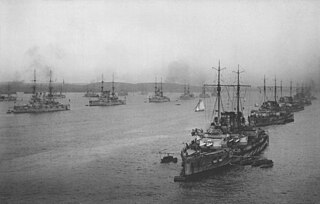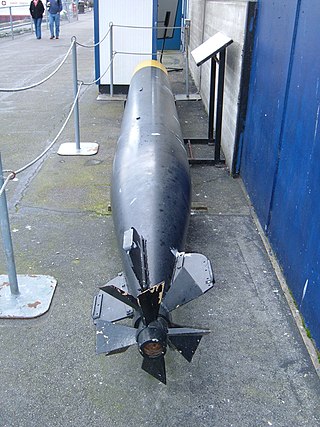Related Research Articles

In naval terminology, a destroyer is a fast, maneuverable, long-endurance warship intended to escort larger vessels in a fleet, convoy, or carrier battle group and defend them against a wide range of general threats. They were originally conceived in 1885 by Fernando Villaamil for the Spanish Navy as a defense against torpedo boats, and by the time of the Russo-Japanese War in 1904, these "torpedo boat destroyers" (TBDs) were "large, swift, and powerfully armed torpedo boats designed to destroy other torpedo boats". Although the term "destroyer" had been used interchangeably with "TBD" and "torpedo boat destroyer" by navies since 1892, the term "torpedo boat destroyer" had been generally shortened to simply "destroyer" by nearly all navies by the First World War.

The Imperial German Navy or the Kaiserliche Marine was the navy of the German Empire, which existed between 1871 and 1919. It grew out of the small Prussian Navy, which was mainly for coast defence. Kaiser Wilhelm II greatly expanded the navy. The key leader was Admiral Alfred von Tirpitz, who greatly expanded the size and quality of the navy, while adopting the sea power theories of American strategist Alfred Thayer Mahan. The result was a naval arms race with Britain, as the German navy grew to become one of the greatest maritime forces in the world, second only to the Royal Navy.

A modern torpedo is an underwater ranged weapon launched above or below the water surface, self-propelled towards a target, and with an explosive warhead designed to detonate either on contact with or in proximity to the target. Historically, such a device was called an automotive, automobile, locomotive, or fish torpedo; colloquially a fish. The term torpedo originally applied to a variety of devices, most of which would today be called mines. From about 1900, torpedo has been used strictly to designate a self-propelled underwater explosive device.

A torpedo boat is a relatively small and fast naval ship designed to carry torpedoes into battle. The first designs were steam-powered craft dedicated to ramming enemy ships with explosive spar torpedoes. Later evolutions launched variants of self-propelled Whitehead torpedoes.

The Type 93 was a 610 mm (24 in)-diameter torpedo of the Imperial Japanese Navy (IJN), launched from surface ships. It is commonly referred to as the Long Lance by most modern English-language naval historians, a nickname given to it after the war by Samuel Eliot Morison, the chief historian of the U.S. Navy, who spent much of the war in the Pacific Theater. In Japanese references, the term Sanso gyorai is also used, in reference to its propulsion system. It was the most advanced naval torpedo in the world at the time.

The Wickes-class destroyers were a class of 111 destroyers built by the United States Navy in 1917–19. Together with the six preceding Caldwell-class and following 156 subsequent Clemson-class destroyers, they were grouped as the "flush-deck" or "four-stack" type. Only a few were completed in time to serve in World War I, including USS Wickes, the lead ship of the class.

Human torpedoes or manned torpedoes are a type of diver propulsion vehicle on which the diver rides, generally in a seated position behind a fairing. They were used as secret naval weapons in World War II. The basic concept is still in use.

The Mark 44 torpedo is a now-obsolete air-launched and ship-launched lightweight torpedo manufactured in the United States, and under licence in Canada, France, Italy, Japan and the United Kingdom, with 10,500 being produced for U.S. service. It was superseded by the Mark 46 torpedo, beginning in the late 1960s. The Royal Australian Navy, however, continued to use it alongside its successor for a number of years, because the Mark 44 was thought to have superior performance in certain shallow-water conditions.

The Mark 45 anti-submarine torpedo, a.k.a. ASTOR, was a submarine-launched wire-guided nuclear torpedo designed by the United States Navy for use against high-speed, deep-diving, enemy submarines. This was one of several weapons recommended for implementation by Project Nobska, a 1956 summer study on submarine warfare. The 19-inch (480 mm)-diameter torpedo was fitted with a W34 nuclear warhead. The need to maintain direct control over the warhead meant that a wire connection had to be maintained between the torpedo and submarine until detonation. Wire guidance systems were piggybacked onto this cable, and the torpedo had no homing capability. The design was completed in 1960, and 600 torpedoes were built between 1963 and 1976, when ASTOR was replaced by the Mark 48 torpedo.

The Mark 37 torpedo is a torpedo with electrical propulsion, developed for the US Navy after World War II. It entered service with the US Navy in the early 1950s, with over 3,300 produced. It was phased out of service with the US Navy during the 1970s, and the stockpiles were sold to foreign navies.

An aerial torpedo is a torpedo launched from a torpedo bomber aircraft into the water, after which the weapon propels itself to the target.

The Mark 14 torpedo was the United States Navy's standard submarine-launched anti-ship torpedo of World War II. This weapon was plagued with many problems which crippled its performance early in the war. It was supplemented by the Mark 18 electric torpedo in the last two years of the war. From December 1941 to November 1943 the Mark 14 and the destroyer-launched Mark 15 torpedo had numerous technical problems that took almost two years to fix. After the fixes, the Mark 14 played a major role in the devastating blow U.S. Navy submarines dealt to the Japanese naval and merchant marine forces during the Pacific War.

The Mark 15 torpedo was the standard American destroyer-launched torpedo of World War II. It was very similar in design to the Mark 14 torpedo except that it was longer, heavier, and had greater range and a larger warhead. The Mark 15 was developed by the Naval Torpedo Station Newport concurrently with the Mark 14 and was first deployed in 1938. It served as a replacement for the Mark 8 torpedo, Mark 11 Torpedo and Mark 12 Torpedo on surface ships with tubes that could accommodate the longer Mark 15; this primarily included destroyers built after 1930. Older destroyers, primarily the Wickes and Clemson classes, continued to use the Mark 8, as did PT boats early in World War II. During the war 9,700 were produced at Newport and at the Naval Ordnance Station Forest Park, Illinois.

Project Kingfisher was a weapons-development program initiated by the United States Navy during the latter part of World War II. Intended to provide aircraft and surface ships with the ability to deliver torpedoes to targets from outside the range of defensive armament, six different missile concepts were developed; four were selected for full development programs, but only one reached operational service.

Ralph Waldo Christie was an admiral in the United States Navy who played a pivotal role in the development of torpedo technologies. During World War II, he commanded submarine operations out of the Australian ports of Brisbane and Fremantle.

The Mark 16 torpedo was a redesign of the United States Navy's standard Mark 14 torpedo in use during World War II. It incorporated war-tested improvements into a weapon designed to be used in unmodified United States fleet submarines. Due to high unit cost and the Mark 14's unreliability issues being solved by mid-1943, they were never put into mass production.
There have been a number of 21-inch (53.3cm) torpedoes in service with the Royal Navy of the United Kingdom.

The Mark 23 torpedo was a submarine-launched anti-surface ship torpedo designed and built by the Naval Torpedo Station for the United States Navy in World War II. It was essentially a Mark 14 torpedo, modified via the removal of its low-speed, long-range setting, leaving the high-speed, short-range feature in place.

Torpedo trials craft are primarily naval auxiliaries used by navies for the development of new naval torpedoes and during practise firings. These craft are designed to track and monitor the torpedo and to be able to locate and retrieve the spent torpedo for analysis, and refurbishment for reuse. Torpedo trials craft had their greatest use during the years around World War II when the torpedo was the primary anti-ship weapon of submarines, destroyers and naval aircraft.

United States Navy submarines, surface ships, and aircraft launch torpedoes, missiles, and autonomous undersea vehicles as part of training exercises. Typically, these training munitions have no warhead and are recovered from the sea and reused. Similarly, new naval weapons under development are launched at sea in performance trials. These experimental units also need to be recovered, in their case to obtain evaluation data. At various points in history, newly manufactured torpedoes were fired as a quality control measure and these, too, had to be recovered before issuing them to the fleet. The U.S. Navy has used a variety of boats to accomplish the retrieval of these test and training munitions. As their missions evolved over the last century they have been variously known as torpedo retrievers, torpedo weapon retrievers, torpedo recovery boats, range support craft, and multi-purpose craft.